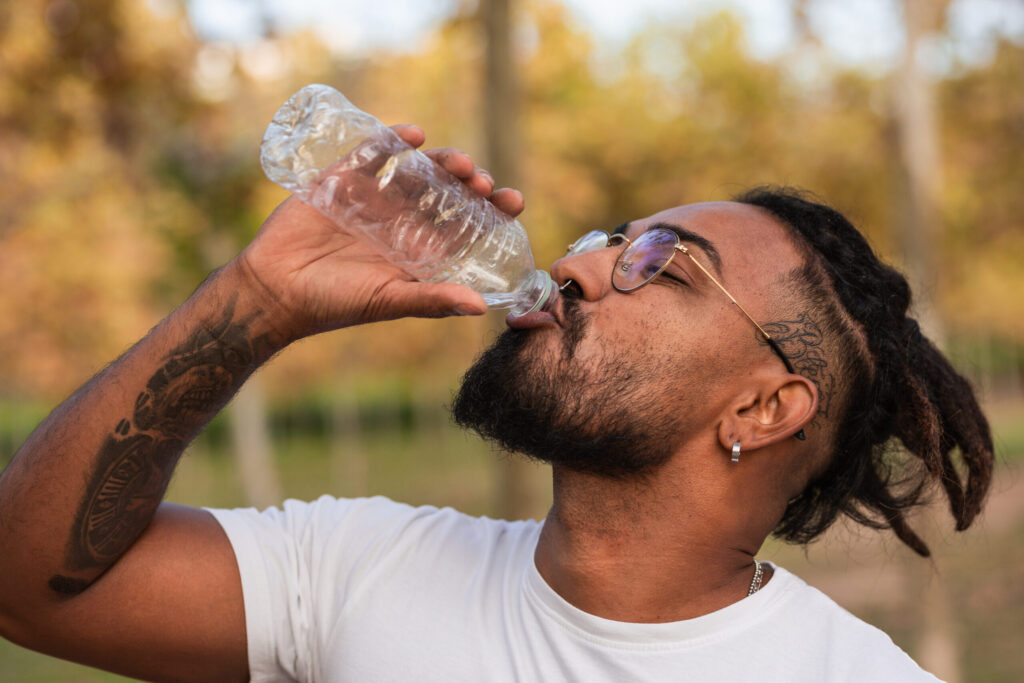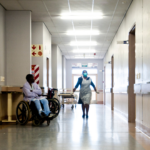- Over the past three decades, new HIV infections have dropped by close to 60% worldwide, including in South Africa.
- On Monday, the results from the country’s latest HIV household survey showed that South Africa’s HIV treatment programme is paying off and the country is well on its way to reaching its international 95-95-95 targets by 2025.
- But ahead of COP28 experts have warned: the climate crisis threatens to put us back in the fight against HIV. Floods and droughts will make it harder to adhere to daily treatment and to access HIV prevention medication, and will increase the demand for transactional sex. We break it down.
In today’s newsletter, Mia Malan breaks down why a hotter earth makes HIV spread. She also recaps what Bhekisisa got up to in November Sign up.

Climate change threatens to undo much of the world’s decades-long progress made with slowing down new HIV infections, experts warn.
“We cannot make adequate progress on public health while rising temperatures change the patterns of infectious diseases and breed pandemics,” World Bank President Ajay Banga, cautioned in a press release.
The World Bank and the Global Fund to Fight HIV, TB and Malaria have now joined hands by signing an agreement to fight the health-related consequences of climate change together.
Since the mid-90s, new HIV infections have dropped by about 60% worldwide — from 3.2-million in 1995 to 1.3-million in 2022. It’s the same in South Africa, with new infections having declined from about 432 000 a year in 1995 to about 165 000 in 2022.
But now changing weather patterns may just tip the scale against the world ending the Aids epidemic by 2030 and the issue is expected to be high on the discussion list of the 65 health ministers who are attending the United Nations Climate Change Conference, COP28, that kicks off in Dubai today.
“To stand a chance at achieving the targets of ending Aids, TB and malaria, we must redouble our efforts to fight these diseases, said Peter Sands, executive director of the Global Fund. “That includes investing to build health systems that can withstand the effects of climate change.”
“On Monday, South Africa’s sixth HIV household survey showed that the proportion of people with HIV in the country declined by 1.3% between 2017 and 2022 and that 90% of people with HIV in the country have been diagnosed. Of those, 91% are on treatment and 94% of people on treatment have such low levels of HIV in their bodies that they cannot infect others.
This is known as viral suppression. But viral suppression can only be achieved if people take their treatment each day, and extreme weather events, such as floods, heatwaves and droughts, experts say, will make it harder for people with HIV to adhere to treatment. Floods and droughts will also decrease access to HIV prevention medication and increase transactional sex as a means of survival.
As a result, HIV will spread faster. When HIV treatment is interrupted, the virus starts to get a foothold in someone’s body and so up their chances of becoming infectious again.
Ironically, COP28 is held in a country with laws that worsen the HIV-related consequences of climate change. The United Arab Emirates criminalises non-marital sex and same-sex relationships, marginalising groups in society who often have a higher chance of getting HIV, such as young women, transgender people and men who have sex men. Evidence clearly shows such approaches make HIV spread because it makes people less likely to access health services out of fear of getting arrested, and therefore less likely to get tested for HIV or access HIV treatment.
However, for the first time since the conference started in 1995 — incidentally around the time when the Aids epidemic was at its peak — health will be top of the agenda.
During extreme weather events linked to climate change, like storms, floods, droughts and wildfires, roads often become unusable, infrastructure such as power lines, sanitation services and health facilities are badly damaged, and masses of people become displaced after having to flee their homes.

So starts the dire public health ripple effect of HIV infection. When people with HIV can’t get their treatment — whether because their access to a clinic has been cut off when a road or bridge is washed away, or because the clinic itself is damaged and doesn’t have medicines in stock — the multiplying virus starts weakening their immune system.
This increases their chances of contracting other infections, the most common being TB. The germ that causes TB spreads easily through the air, so staying in crowded conditions — as often happens in the aftermath of a natural disaster such as a flood or storm when people stay in rescue shelters — is the perfect breeding ground for TB.
Once TB gets a stronghold in someone’s body, other health conditions such as diabetes or heart disease can set in too, which in a nasty feedback loop, make it harder to treat TB. Research shows that people with diabetes are twice as likely to die from TB if they develop the lung disease and four times as likely to fall ill again later even if they were cured of TB before.
Poor hygiene conditions, as often develop in the wake of a natural disaster, make it even harder for people with HIV to stay safe, as their bodies might not be able to ward off germs that cause cholera or a disease such as malaria spread by mosquitoes that breed in standing water.
Experts say that the Earth’s atmosphere will likely be 1.5°C warmer by 2050 than it was in the mid-19th century — with far-reaching implications for the global climate. With the window for turning this around or even just halting global warming fast closing, the focus should be on adapting to a warmer world rather than trying to fight it, which means governments have to put plans in place to build resilient systems — including for public healthcare — to keep people safe.
In the latest episode of Health Beat, Bhekisisa’s monthly TV programme, Mia Malan spoke to James Chrispin, a medical doctor and health researcher in Tanzania, who has seen firsthand how extreme weather events can upend public health service delivery.
Read the full interview below or watch the programme here.
Mia Malan (MM): Will events linked to climate change — for example, floods — affect how fast HIV spreads?
James Chrispin (JC): Floods make it harder for people with HIV [everywhere] to access good treatment and care because [they cause] destruction of infrastructure [like roads], and also health facilities. [During floods] people have lost their card [showing] follow-up [appointments] and treatment progress [to staff at] the clinic, and some even complain that they’ve lost their medication. But we have also seen that floods cause migration of people, because some [move] to other areas [where] floods occur less often. [This can mean that they are] forced to travel to other places, where they are far from treatment services, so they’re lost to follow-up and they can’t be tracked.
HIV treatment needs to be taken daily to stop the virus from multiplying in someone’s body. This keeps the level of the virus low, which means there’s too little HIV in someone’s body to transmit the virus to someone else.
When someone’s viral level is low, it’s also easier for them to stay healthy, because the virus has less chance to attack immune cells that help the body fight off germs. However, when people can’t get their treatment during a flood and they interrupt their daily treatment, their immune system could get weaker again. This could open them up to getting infections that they normally won’t get (these are called opportunistic infections).
After the KwaZulu-Natal floods in April last year, which led to more than 40 000 people having to flee their homes and roads and other services were seriously damaged, Bhekisisa reported that Mfundo Shezi, then 32, had lost both his month’s packet of antiretrovirals and his ID book during the rains — which meant he couldn’t get a refill for his HIV pills. He had been on treatment since 2021, but “on that day, I missed a dose for the first time,” he recounted.
Having plans in place to deal with such extreme events can help, though. For example, disaster relief teams working in the Ohangwena region in Namibia, where floods occur often, begin to hand out six months’ worth of HIV treatment to people when it looks like heavy rains are on the way. Health workers remind their patients to collect more medication and nonprofits and home-based care organisations explain to people what to expect during floods and how they can stay safe and healthy.
MM: How does interrupting treatment because of a climate disaster such as a flood affect the spread of other infectious diseases?
JC: People with HIV already have a weakened immune system, and they’re more likely to get TB or pneumonia. In areas where there was a flood, people are more likely to get these diseases, because they may [have] to go live in a rescue camp [where overcrowded conditions make it easy for diseases such as TB and pneumonia to spread]. But a flood can also destroy sanitation [systems] and so lead to the outbreak of waterborne diseases [such as cholera] and other opportunistic infections. People with HIV [and are not on treatment] are more likely to get these infections because they already have weakened immune systems.
In the aftermath of a natural disaster, people can lose their jobs and social injustices like poverty, inequality and gender-based violence can become worse. This can add stress in people’s lives, which can affect their decisions and how they cope with adversity. Moreover, it can start a cycle where people may offer sex in exchange for support to help them survive.
MM: Do people have riskier sexual behaviour during floods, which will make it easier to get HIV?
JC: Yes, during a flood people are more likely to [have] risky sexual behaviour [for example, having unprotected sex], which can put them at risk to contract HIV. A vivid example we’ve seen is that people [resort] to transactional sex for food and money. During a flood, there are people who already have economic and social stressors, and so they use transactional sex [to support] a living.
Transactional sex is when someone offers sex in exchange for the means to support their life. It’s different from sex work, because the reward — whether in the form of money, food or other goods — is implied rather than being explicitly paid for. This type of sexual encounters often goes along with women at the receiving end of an unequal gender, age or power relationship, which can feed risky behaviour such as such condomless sex, alcohol or substance abuse or violence towards women. A report by UNAids shows that in some countries in sub-Saharan Africa, up to 50% of women have been in situations where they offered sex in exchange for some sort of reward. Many of these women are between 15 and 24 years old and have a much higher chance to contract HIV than men.
MM: What is the impact of stress from an event like a flood on mental health?
JC: People can develop [mental health problems like] depression and anxiety. Particularly, for people with HIV, mental health is important because they need to have good adherence to their medication. If someone is mentally not okay, [they] will not be able to adapt [to get their] medication or they may miss follow-up at the clinic, which [can] affect the incidence of HIV.
Want to know what other health issues climate change will affect? Click through to our special reports to see all our coverage or watch our full Health Beat episode on climate change.
Linda Pretorius is Bhekisisa’s content editor. She has a PhD in biosystems from the University of Pretoria has been working as a science writer, editor and proofreader in the book industry and for academic journals over the past 15 years. At Bhekisisa she helps authors to shape and develop their stories to pack a punch.







